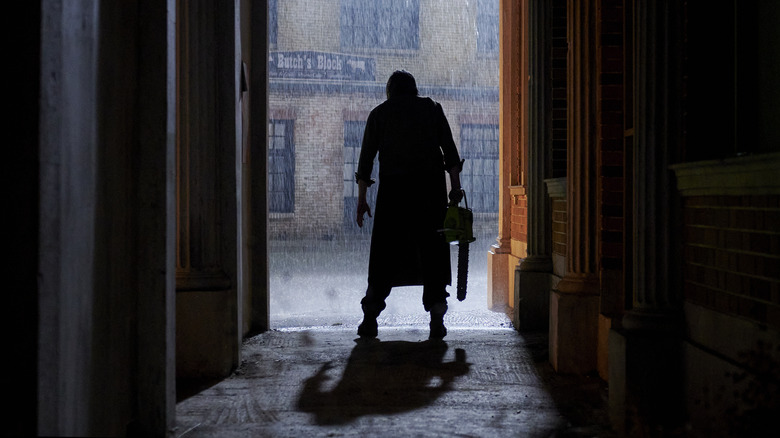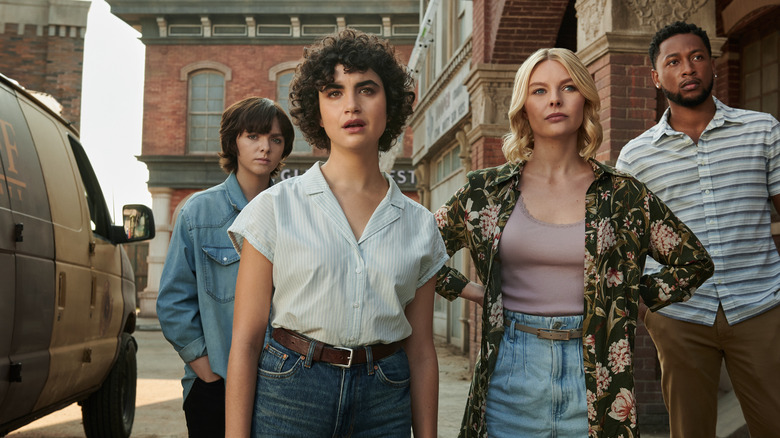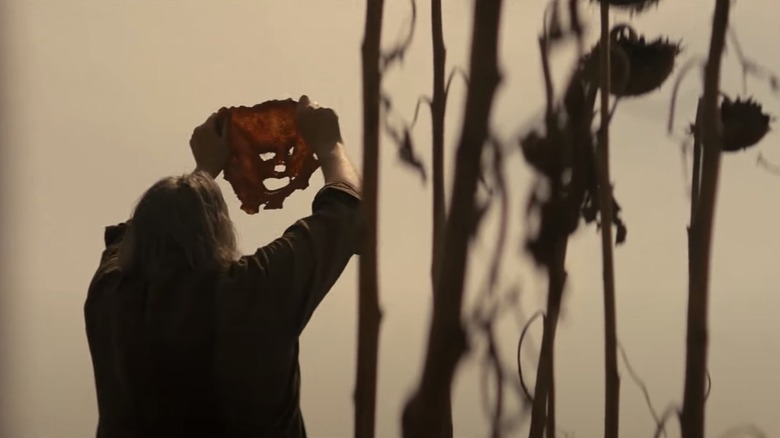Texas Chainsaw Massacre Review: An Extremely Bloody, Extremely Disappointing Sequel
Tobe Hooper's 1974 "The Texas Chain Saw Massacre" is one of the scariest movies ever made. There are several factors backing up such a big claim, but what really makes Hooper's film so damn effective is how real it all feels. The film isn't based on a true story (although, like "Psycho," it drew on the true story of Ed Gein), but it presents itself in a manner that feels authentic. The opening narration (provided by John Larroquette) dryly informing of us the horrors to come coupled with the grainy footage gives the entire thing a cinéma vérité vibe. On top of that, when the horror starts, it never lets up, resulting in unrelenting scenes that feel utterly unhinged and completely deranged.
The climactic, apocalyptic images — Marilyn Burns as final girl Sally Hardesty, drenched in blood and simultaneously screaming and laughing hysterically as she's driven away to safety, all while the terrifying Leatherface dances about, swinging his buzzing chainsaw against the sickly orange sky — do not provide us with catharsis. We are instead left with a nightmarish, bone-chilling certainty that somewhere out there, on the back roads of Texas (or anywhere secluded, really), unspeakable horrors await, ready to corrupt and destroy any semblance of sanity and safety.
It was all so raw, so horrifying, and so unique that it became nearly impossible to replicate. When Hooper returned for a sequel (1986's "The Texas Chainsaw Massacre Part 2"), he didn't even try to replicate what made the original film special. Instead, he took a meta approach and created a sequel that leaned into macabre, absurdist comedy, effectively mocking the dark forces he had conjured up. Since then, any attempts to keep the franchise going have resulted in sequels that more or less remake the original movie. There was even an actual remake, the surprisingly not-bad 2003 "The Texas Chainsaw Massacre" (the practice of separating the words "chain" and "saw" stopped immediately after the '74 original).
Now, here we go again with "Texas Chainsaw Massacre" (in true Facebook fashion, they ditched the "the"), a new entry that serves as a legacy sequel. You know the deal: it's a new movie that sort of feels like a remake and a reboot while also bringing back characters from the original. "Star Wars" did it. The "Jurassic" series did it. "Halloween" did it. "Scream" just did it very recently. And now it's time for "Chainsaw" to get in on that action. The 2018 "Halloween" is the biggest influence here, so much so that there are moments where it feels as if the folks behind this film literally watched David Gordon Green's trip to Haddonfield and said, "Let's just do that, but with Leatherface." In "Texas Chainsaw Massacre," none of the other sequels happened. Or if they did, no one remembers them. Instead, only the events of the original film are mentioned (via an admittedly enjoyable fictional true crime documentary we see at the start, bringing back Larroquette as narrator). And like "Halloween" final girl Laurie Strode, Sally Hardesty is still out there, haunted by her brush with death and determined to be prepared to defend herself properly this time.
Canceling Leatherface
But Sally (played here by Olwen Fouéré, stepping in for the late Marilyn Burns) isn't the main character. She mostly exists on the edges of the film, biding her time and waiting for her big moment. In the meantime, we're introduced to a new group of potential victims. This youthful gang is headed to a small, mostly abandoned Texas town with the hopes of ... well, it's not entirely clear. The muddled script by Chris Thomas Devlin glosses over a lot of details, probably because everyone just wanted to get to the killing. The plan seems to involve auctioning off the remains of the town to start some sort of new utopian community, or something like that (the official synopsis brands it "an idealistic new business venture," which is just as vague). This is the brainchild of Dante (Jacob Latimore) and Melody (Sarah Yarkin), who have some sort of ill-defined online following — one big enough to inspire a whole busload of folks to show up for the auction (and, you guessed it, run afoul of a certain chainsaw-wielding killer). "Our post is blowing up!" Dante says while looking at his phone at the start of the film, and that's pretty much the bulk of the information we get in regards to what these folks are up to.
Dante has brought along his girlfriend Ruth (Nell Hudson), a character who is so poorly drawn she might as well not exist. Melody has also brought someone: her teen sister Lila (Elsie Fisher). Melody is overprotective of Lila, and with good reason — the teenager survived a mass shooting at her high school. Using a school shooting as character development is potentially ghoulish, but "Texas Chainsaw Massacre" takes things further (and makes things worse) by adopting a weird, indecipherable stance on the matter. Melody lets off a rant about gun control earlier in the pic, but we later see that Lila is ... fascinated by guns? As if her school shooting experience (which included being shot; she has the scars to prove it) has turned her into a gun fanatic.
Using real-world issues like gun control and gentrification as a backdrop for a horror film isn't a bad idea, at least in theory. But "Texas Chainsaw Massacre" really never nails down what it wants to say about any of this stuff. When the characters spot a Confederate flag hanging from one of the buildings in town, the film seems to imply that it's really not such a bad thing and that these youngsters are overreacting for the sake of being "woke." That "Let's laugh at the woke young people!" stance is underscored at a later moment when Leatherface shows up and an unnamed extra points a cellphone into the killer's face and threatens to "cancel" him. It's painfully stupid stuff, to the point of being intellectually offensive. Just what is "Texas Chainsaw Massacre" trying to say here? I don't know, and I doubt the filmmakers know, either. They simply want to drop a bunch of non-descript characters in one spot and then cut them into pieces. And if that's really all you're looking for here, I guess you won't be disappointed.
Lots of blood
Here's the thing about Leatherface: He's not your typical slasher. He's not a silent, crafty stalker à la Michael Myers. He's not some undead party crasher like Jason Voorhees. He's definitely not a quip-heavy prankster in the spirit of Freddy Krueger. No, Leatherface is something else. As portrayed by Gunnar Hansen in the original film, Leatherface is a hulking, squealing oddity. He's so scary because he feels both real and surreal. It's hard to believe that someone like Michael Myers really exists out there. But Leatherface? A bulky, deranged guy who jibbers and slobbers and wears the skin of others as a mask? That may not be a common character, but it feels real. Primarily because the whole "backwoods weirdo who wears skin masks" thing was real, in the form of Ed Gein, a murderer and grave robber whose ghoulish deeds inspired Leatherface (and Norman Bates in "Psycho," and Buffalo Bill in "Silence of the Lambs").
Even scarier: Leatherface wasn't alone. Almost all infamous horror movie slashers (with the notable exception of the many Ghostfaces in the "Scream" series) are loners by nature. But Leatherface was just one part of an overall freaky family of cannibals and lunatics, and that made the whole thing all the more horrifying. The unlucky characters in the original movie didn't just have to deal with Leatherface — they had to contend with his malicious kin, all of whom reveled in abject cruelty. None of that applies here. There's no mention of Leatherface's nightmare family. Instead, the killer has seemingly retired, living with an older woman who has adopted him as her son. Is she aware of his horrific past? Maybe, maybe not. In any case, "Texas Chainsaw Massacre" gives us the impression that if everyone would just leave poor Leatherface alone, he'd never hurt another soul. That, too, feels completely wrong for the character. It also adds an extra layer of ickiness to the whole thing, as if the hapless victims are really to blame for their own grisly dismemberment.
Sure enough, after our young new characters have a bad run-in with Leatherface's new mom he takes up killing again, getting himself a new face (I won't reveal how, but I will say it's one of the few decisions this film makes that I appreciated) and commencing with the slaughter. And here is where "Texas Chainsaw Massacre" steps up its game, because the amount of graphic violence on display here is relentless. Of course, it's worth pointing out that for all the original film's horrors, it wasn't exactly overly gory. Here, director David Blue Garcia revels in the red stuff, and to the film's credit, a lot of the blood and gore are created via practical make-up effects — an old school practice that has sadly gone by the wayside in the era of CGI-generate plasma.
And again: If that's all you're looking for, have fun. Gorehounds will certainly have much to love here, as Leatherface's chainsaw (and hammer, and other random objects) obliterates one poor soul after another. But is any of it scary? There's a literal massacre aboard a party bus that's so over-the-top that it becomes comical, and this, too, is just another nail in the film's coffin. I know it's probably asking too much that the ninth installment of a franchise recapture what made the original so special, but to compare the no-nonsense terrors of the 1974 "Texas Chain Saw Massacre" against the new "Texas Chainsaw Massacre" is downright depressing. Perhaps this is an issue of branding. Perhaps if this were a brand-new slasher pic with a new killer inspired by Leatherface, things would go down smoother. But that's not what this is. This is a movie that very much wants to call back to the original — and in doing so, it inadvertently reminds us of how much better the original was, and how bad this is. Perhaps that ultimately makes "Texas Chainsaw Massacre" perfect for Netflix. You can throw it on in the background while you go about other things, and glance up at the screen whenever you hear Leatherface fire up the old chainsaw. Or maybe you should just skip this hunk of junk entirely and re-watch the original movie instead.
/Film Rating: 4 out of 10


